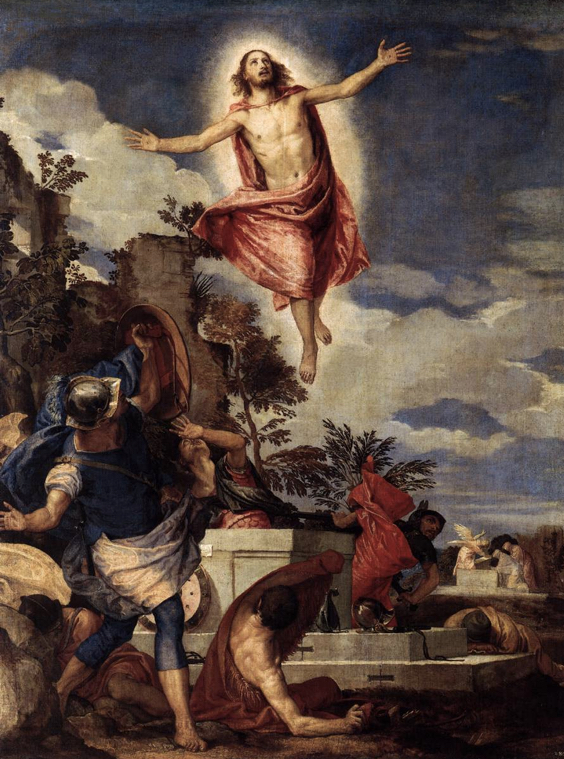 Paolo Veronese - The resurrection of ChristIn the Gospel of Matthew, we find an awe-inspiring account of the resurrection of Jesus Christ, an event that stands as the cornerstone of the Christian faith and the ultimate triumph over death and despair. This profound narrative unfolds with the dawn of the first day of the week, as Mary Magdalene and another Mary journey to the tomb where Jesus had been laid to rest.
Paolo Veronese - The resurrection of ChristIn the Gospel of Matthew, we find an awe-inspiring account of the resurrection of Jesus Christ, an event that stands as the cornerstone of the Christian faith and the ultimate triumph over death and despair. This profound narrative unfolds with the dawn of the first day of the week, as Mary Magdalene and another Mary journey to the tomb where Jesus had been laid to rest.
Their purpose is to pay their respects to the one they loved and revered, unaware of the extraordinary events that would unfold before their eyes. As they approach the tomb, they are met with a scene of divine grandeur – a great earthquake shakes the ground, and an angel of the Lord descends from heaven, his appearance radiant as lightning and his clothing white as snow.
The guards stationed at the tomb, overwhelmed with fear at the angel's presence, become like dead men, struck immobile by the awe-inspiring sight before them. The angel, recognizing the women's apprehension, offers words of comfort and reassurance, saying, "Do not be afraid! I know that you are seeking Jesus the crucified. He is not here, for he has been raised just as he said."
With these words, the angel proclaims the miraculous truth of Jesus' resurrection, fulfilling the promise he had made to his disciples during his earthly ministry. The women are invited to behold the empty tomb, the tangible evidence of Jesus' victory over death, and are entrusted with a divine mission – to go quickly and proclaim the good news of his resurrection to the disciples.
Read more: 10: The Resurrection: Hope Renewed and Fear Overcome
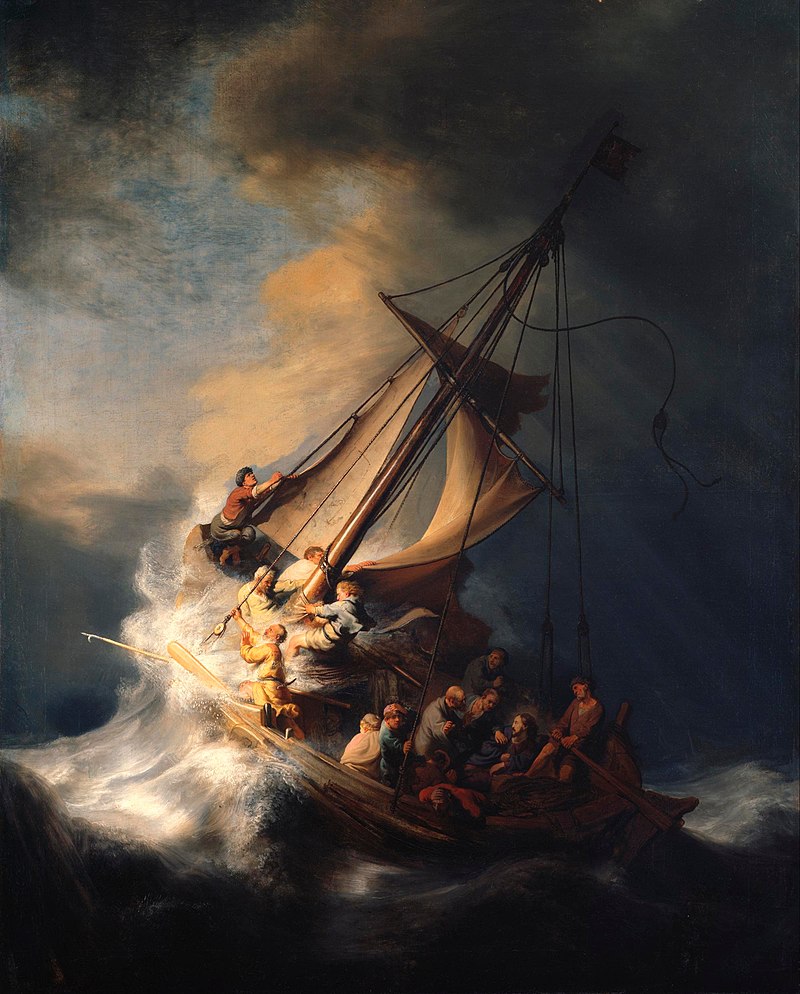 Rembrandt - The Storm on the Sea of GalileeIn the Gospel of Mark, we encounter a profound account of Jesus' ability to calm a raging storm at sea, a miraculous event that not only demonstrates his power over the forces of nature but also offers timeless lessons about faith, trust, and finding peace in the midst of life's storms.
Rembrandt - The Storm on the Sea of GalileeIn the Gospel of Mark, we encounter a profound account of Jesus' ability to calm a raging storm at sea, a miraculous event that not only demonstrates his power over the forces of nature but also offers timeless lessons about faith, trust, and finding peace in the midst of life's storms.
The narrative unfolds as Jesus and his disciples embark on a journey across the Sea of Galilee, leaving the crowds behind and venturing into the unknown. As evening draws near, a sudden and violent squall descends upon them, causing the waves to surge and break over the boat. The disciples, seasoned fishermen who are accustomed to the perils of the sea, find themselves in a dire situation as the boat begins to fill with water.
In the midst of the chaos and turmoil, Jesus remains seemingly unperturbed, asleep on a cushion in the stern of the boat. His disciples, gripped by fear and desperation, awaken him with a plea tinged with desperation: "Teacher, do you not care that we are perishing?" In response, Jesus rises from his slumber, rebukes the wind, and commands the sea to be still.
With a single word, "Quiet! Be still!" Jesus calms the storm, and immediately, there is a great calm that descends upon the sea. The wind ceases its howling, and the waves subside, leaving the disciples in awe of the miraculous display of Jesus' power over nature.
Read more: 9. Finding Peace in the Storm: The Calming of a Tempestuous Sea by Jesus
This year (2024), the Church is facing a conundrum, all because Holy Week was in the last week of March, Easter was on March 31st and the Octave of Easter ended on April 7th. As a result, the celebration of the Feast of the Annunciation was moved to April 8th from the normal March 25th since Holy Week takes precedence over all other celebrations that occur.
What to do with this odd situation? Ignore it? That would make Jesus a “preemie” this year.
Or, should Christmas therefore be moved to January 8th? That would respect the nine-month perfect pregnancy which the Church has for John the Baptist, Mary, and especially Jesus. Fun fact: January 8th also happens to be Elvis’ birthday and another singer/guitarist of middling talent.
But, that would mess up the Advent season. It would have to start two weeks later. “Black Friday” would have to be moved as well from the traditional day after Thanksgiving. And shoppers wouldn’t have the pressure of buying gifts at the last moment on the 24th of December. They would be able to wait until the 7th of January! What about school vacations (except for colleges)? And, The Solemnity of the Motherhood of Mary would come before she has given birth.
A conundrum indeed!
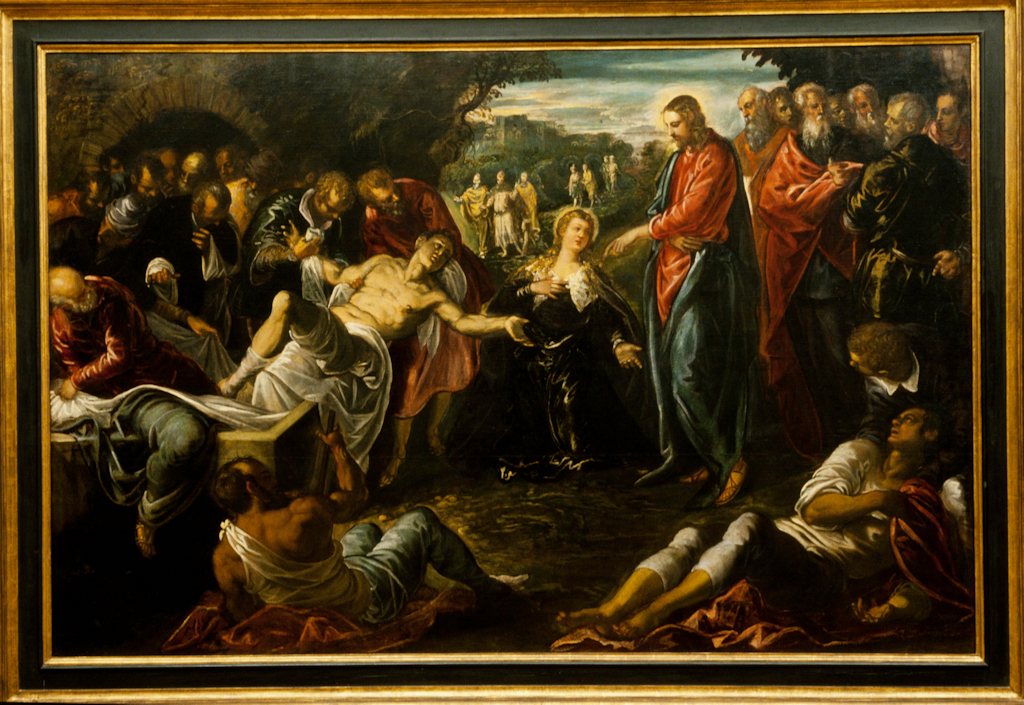 The Raising of Lazarus - Jacopo Tintorerro MiaThe raising of Lazarus from the dead, as recounted in the Gospel of John, stands as one of the most profound and miraculous events in the ministry of Jesus Christ. This extraordinary narrative not only demonstrates Jesus' divine power over death but also reveals profound truths about faith, resurrection, and the glory of God.
The Raising of Lazarus - Jacopo Tintorerro MiaThe raising of Lazarus from the dead, as recounted in the Gospel of John, stands as one of the most profound and miraculous events in the ministry of Jesus Christ. This extraordinary narrative not only demonstrates Jesus' divine power over death but also reveals profound truths about faith, resurrection, and the glory of God.
The story begins with the introduction of Lazarus, a man from Bethany who falls gravely ill. His sisters, Mary and Martha, send word to Jesus, their beloved friend and teacher, informing him of Lazarus' condition and expressing their hope for his intervention. Upon hearing the news, Jesus assures his disciples that Lazarus' illness will not end in death but rather will serve as an occasion for the glory of God to be revealed.
Despite his deep love for Lazarus and his sisters, Jesus delays his journey to Bethany, waiting for two days before embarking on the journey. By the time he arrives, Lazarus has already been in the tomb for four days, and the mourning for his death is in full swing. Martha, upon hearing of Jesus' approach, goes out to meet him, expressing both grief and faith in Jesus' ability to bring about resurrection.
Read more: 8. The Raising of Lazarus: A Miracle of Faith and Resurrection
![]() Christ Healing the Hemorrhaging Woman - Ivan RutkovychIn the Gospel of Matthew, we encounter a powerful account of a woman who suffered from hemorrhages for twelve years, a condition that not only afflicted her physically but also socially and spiritually. Despite enduring years of suffering and seeking medical help to no avail, she remained undeterred in her pursuit of healing, clinging to a glimmer of hope that lay in the person of Jesus Christ.
Christ Healing the Hemorrhaging Woman - Ivan RutkovychIn the Gospel of Matthew, we encounter a powerful account of a woman who suffered from hemorrhages for twelve years, a condition that not only afflicted her physically but also socially and spiritually. Despite enduring years of suffering and seeking medical help to no avail, she remained undeterred in her pursuit of healing, clinging to a glimmer of hope that lay in the person of Jesus Christ.
The woman's faith is exemplified in her courageous act of reaching out to touch the tassel on Jesus' cloak, believing that even a brief encounter with him would bring about her restoration. In a moment of divine intervention, Jesus turns around and sees her, acknowledging her faith and declaring, "Courage, daughter! Your faith has saved you." Instantly, the woman is healed, freed from the burden of her affliction, and restored to wholeness.
This narrative of the woman with the issue of blood serves as a profound testament to the transformative power of faith and the boundless compassion of Jesus Christ. Despite the societal stigma attached to her condition and the despair that may have clouded her spirit, the woman persevered in her faith, recognizing Jesus as the source of her healing and restoration.
Read more: 7. The Healing Touch: A Woman's Faith and Restoration
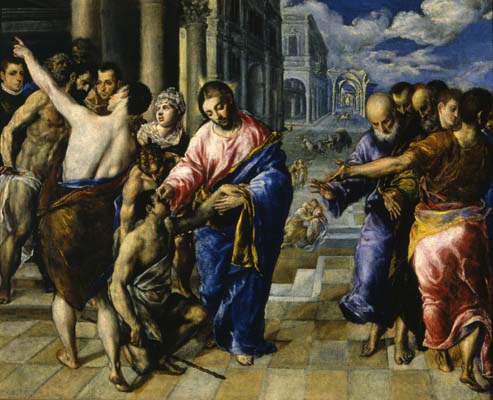 Healing of the Man Born Blind - El Greco 1573In the Gospel of John, we encounter a profound narrative of healing that transcends physical restoration to unveil deeper truths about divine purpose and the transformative power of faith. The story begins with Jesus encountering a man blind from birth, prompting his disciples to inquire about the cause of his condition – whether it was the result of his sin or that of his parents.
Healing of the Man Born Blind - El Greco 1573In the Gospel of John, we encounter a profound narrative of healing that transcends physical restoration to unveil deeper truths about divine purpose and the transformative power of faith. The story begins with Jesus encountering a man blind from birth, prompting his disciples to inquire about the cause of his condition – whether it was the result of his sin or that of his parents.
Jesus' response challenges conventional notions of sin and suffering, shifting the focus from assigning blame to recognizing an opportunity for the works of God to be made visible. He declares, "Neither he nor his parents sinned; it is so that the works of God might be made visible through him." This statement underscores the redemptive purpose inherent in human suffering, as it becomes a canvas upon which God's glory and transformative power are displayed.
Moreover, Jesus uses this encounter to impart a profound lesson about the urgency of doing the works of God while there is still time. He declares, "We have to do the works of the one who sent me while it is day. Night is coming when no one can work." This admonition serves as a call to action, urging his followers to seize the opportunity to participate in God's redemptive work in the world.
As Jesus proceeds to heal the man born blind, he demonstrates his divine authority and power through a simple yet profound act. He spits on the ground, makes clay with the saliva, and applies it to the man's eyes, instructing him to wash in the Pool of Siloam. The man obeys, and in an instant, his sight is restored, marking a miraculous transformation that symbolizes the illumination of spiritual truth and the revelation of God's redemptive power.
Read more: 6. The Healing of the Man Born Blind: A Revelation of Divine Purpose
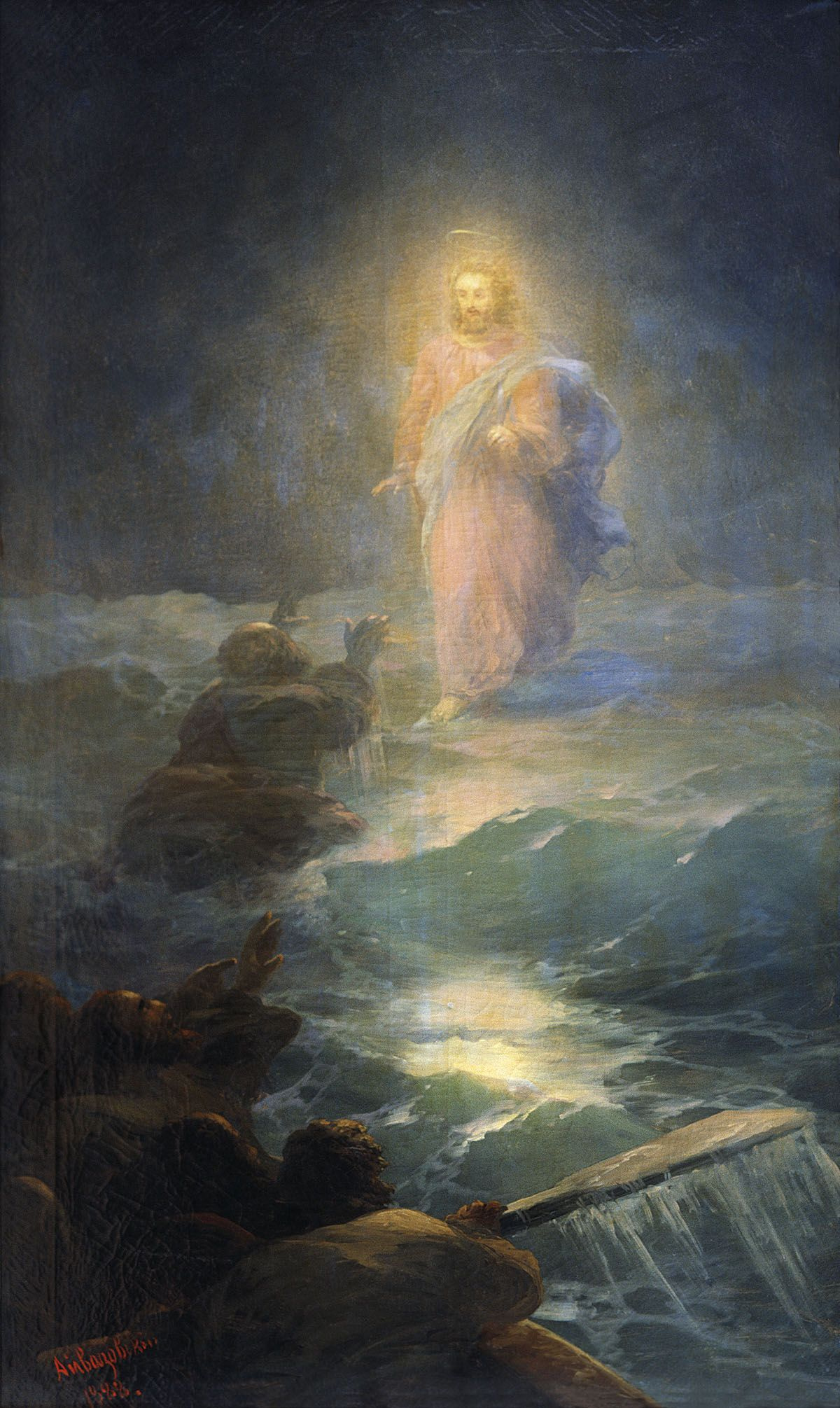 Walking on water Ivan Aivazovsky 1888The biblical account of Jesus walking on water, as recorded in the Gospels, is a timeless narrative that continues to captivate hearts and minds, offering profound insights into the nature of faith, trust, and the divine presence amidst life's storms. This extraordinary event unfolds amidst a backdrop of tumultuous waves and winds, serving as a powerful demonstration of Jesus' authority over nature and his ability to instill courage and faith in his disciples.
Walking on water Ivan Aivazovsky 1888The biblical account of Jesus walking on water, as recorded in the Gospels, is a timeless narrative that continues to captivate hearts and minds, offering profound insights into the nature of faith, trust, and the divine presence amidst life's storms. This extraordinary event unfolds amidst a backdrop of tumultuous waves and winds, serving as a powerful demonstration of Jesus' authority over nature and his ability to instill courage and faith in his disciples.
The scene is set as Jesus, having dismissed the crowds, retreats to a mountain to pray, seeking solitude and communion with his heavenly Father. Meanwhile, his disciples embark on a journey across the Sea of Galilee, only to find themselves battling against fierce winds and waves as they struggle to reach their destination. In the midst of the storm, Jesus appears to them, walking on the water during the fourth watch of the night.
Upon catching sight of Jesus, the disciples are gripped by fear and confusion, mistaking him for a ghost amidst the tumultuous sea. In response, Jesus speaks words of reassurance and comfort, urging them to take courage and dispelling their fears with the simple declaration, "It is I; do not be afraid."
It is Peter, ever impulsive and eager in his faith, who responds to Jesus' call with a bold request: "Lord, if it is you, command me to come to you on the water." In a remarkable display of faith, Peter steps out of the boat and begins to walk on the water towards Jesus. However, as he becomes aware of the raging winds and waves, fear creeps in, causing him to falter and begin to sink.
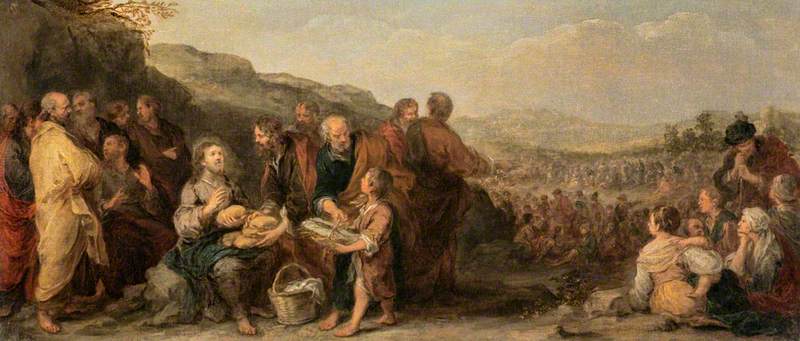 Murillo, Bartolome Esteban; The Miracle of the Loaves and the FishesIn the Gospel narratives, the account of the return of the Twelve Apostles to Jesus and the subsequent feeding of the five thousand stands as a testament to the compassionate heart and miraculous provision of Jesus Christ. This powerful episode unfolds against the backdrop of a deserted place, where Jesus withdraws in a boat seeking solitude after receiving news of the death of John the Baptist. However, his solitary retreat is interrupted by a vast crowd who follows him on foot from their towns, hungering for his healing touch and life-giving words.
Murillo, Bartolome Esteban; The Miracle of the Loaves and the FishesIn the Gospel narratives, the account of the return of the Twelve Apostles to Jesus and the subsequent feeding of the five thousand stands as a testament to the compassionate heart and miraculous provision of Jesus Christ. This powerful episode unfolds against the backdrop of a deserted place, where Jesus withdraws in a boat seeking solitude after receiving news of the death of John the Baptist. However, his solitary retreat is interrupted by a vast crowd who follows him on foot from their towns, hungering for his healing touch and life-giving words.
Upon seeing the multitude, Jesus' heart is moved with compassion, and he begins to cure their sick, demonstrating his unwavering commitment to minister to the physical and spiritual needs of those who seek him. As the day progresses and evening approaches, the disciples express concern for the well-being of the crowd, noting the deserted nature of the place and the lateness of the hour. They suggest sending the people away to nearby villages to procure food for themselves.
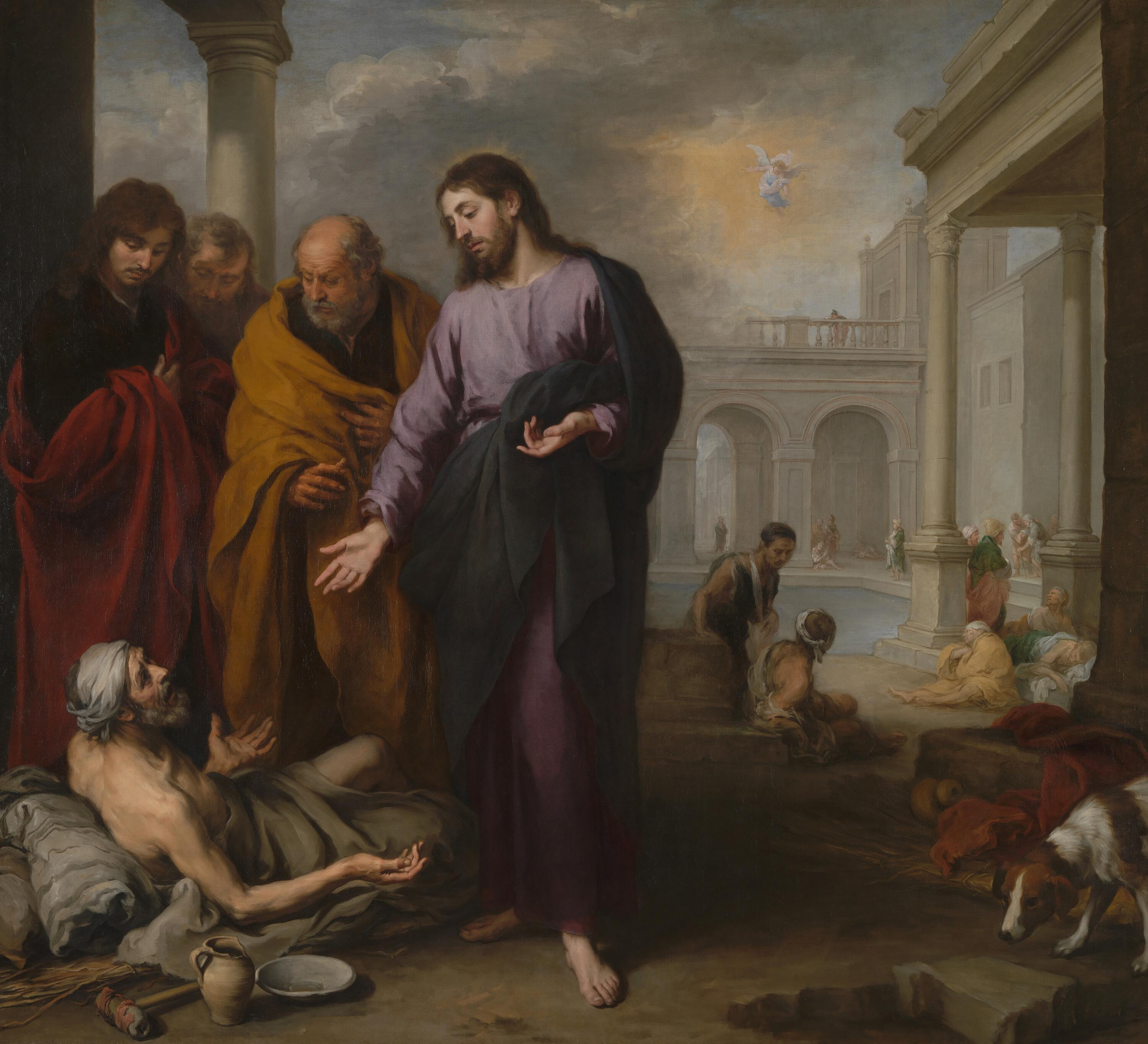 Christ Healing the Paralytic at the Pool of Bethesda by Bartolome Esteban MurilloIn the heart of Jerusalem, near the Sheep Gate, lies a pool known in Hebrew as Bethesda, surrounded by five porticoes. This site, steeped in history and significance, serves as the backdrop for a profound encounter between Jesus and a man who had been afflicted with illness for thirty-eight years. The narrative unfolds as a testament to Jesus' compassion and power to bring about miraculous healing.
Christ Healing the Paralytic at the Pool of Bethesda by Bartolome Esteban MurilloIn the heart of Jerusalem, near the Sheep Gate, lies a pool known in Hebrew as Bethesda, surrounded by five porticoes. This site, steeped in history and significance, serves as the backdrop for a profound encounter between Jesus and a man who had been afflicted with illness for thirty-eight years. The narrative unfolds as a testament to Jesus' compassion and power to bring about miraculous healing.
The scene is set with a description of the pool of Bethesda, where a multitude of individuals suffering from various ailments – the ill, blind, lame, and crippled – gather in hope of receiving healing. Among them is a man who has languished in illness for nearly four decades, his life marked by suffering and despair.
Jesus, in his divine wisdom and compassion, approaches the man and engages him in a simple yet profound question: "Do you want to be well?" This inquiry goes beyond the surface level of physical healing; it delves into the depths of the man's desire for restoration and transformation.
The man, in his response, reveals the obstacles that have hindered him from receiving healing – the lack of assistance to lower him into the pool when its waters are stirred, believed to possess healing properties. His words resonate with a sense of resignation and hopelessness, reflecting the struggles faced by many who grapple with illness and adversity.
Read more: 3. Healing at the Pool of Bethesda: A Testament to Jesus' Compassion
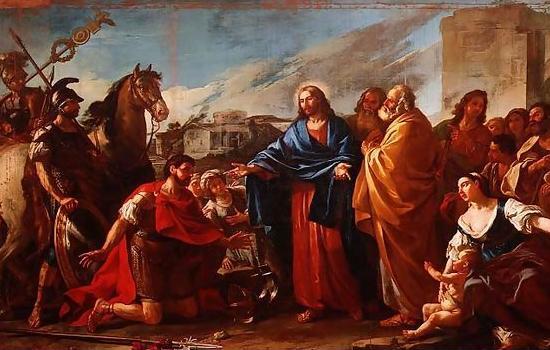 Healing the royal officials son by Joseph Marie Vien 1752In the Gospel of John, the account of Jesus' second sign at Cana offers a profound narrative of faith, healing, and the transformative power of belief. Set in the town of Cana in Galilee, this miracle involves a royal official whose son is gravely ill in Capernaum. Let's delve into the rich layers of this narrative and explore its timeless lessons.
Healing the royal officials son by Joseph Marie Vien 1752In the Gospel of John, the account of Jesus' second sign at Cana offers a profound narrative of faith, healing, and the transformative power of belief. Set in the town of Cana in Galilee, this miracle involves a royal official whose son is gravely ill in Capernaum. Let's delve into the rich layers of this narrative and explore its timeless lessons.
The story unfolds with the introduction of a royal official, a man of status and authority, whose desperation leads him to seek out Jesus upon hearing of his arrival in Galilee. Faced with the looming specter of his son's impending death, the official approaches Jesus with a plea for healing. Despite the urgency of the situation, Jesus responds cryptically, challenging the crowd's dependence on signs and wonders as a condition for belief.
In the face of Jesus' enigmatic response, the royal official persists in his plea, pleading with Jesus to come down and heal his dying son. Jesus, however, offers a surprising directive: "You may go; your son will live." In this moment, the official is confronted with a test of faith – to trust in Jesus' words without tangible proof or to succumb to doubt and despair.
Remarkably, the official chooses to believe. His journey back to Capernaum becomes a testament to his newfound faith as he encounters his servants on the road, who deliver the news of his son's miraculous recovery. The timing of the healing aligns precisely with Jesus' declaration, serving as a tangible confirmation of the divine intervention at work.
Read more: 2. The Second Sign at Cana: A Story of Faith and Healing
The life and teachings of Jesus Christ, chronicled in the New Testament of the Bible, are rich with accounts of miraculous deeds that attest to his divine nature and authority. These miracles serve as powerful demonstrations of Jesus' compassion, mastery over nature, and ability to bring about profound transformations in the lives of individuals. In this exploration, we delve into ten notable miracles attributed to Jesus in the New Testament, each revealing unique facets of his character and mission. From turning water into wine to calming stormy seas, these miracles offer glimpses into the extraordinary power and love of the Son of God. Join us on this 10-week journey as we uncover the significance and impact of these miraculous events in the ministry of Jesus Christ.
1. The Wedding at Cana: A Revelation of Divine Grace
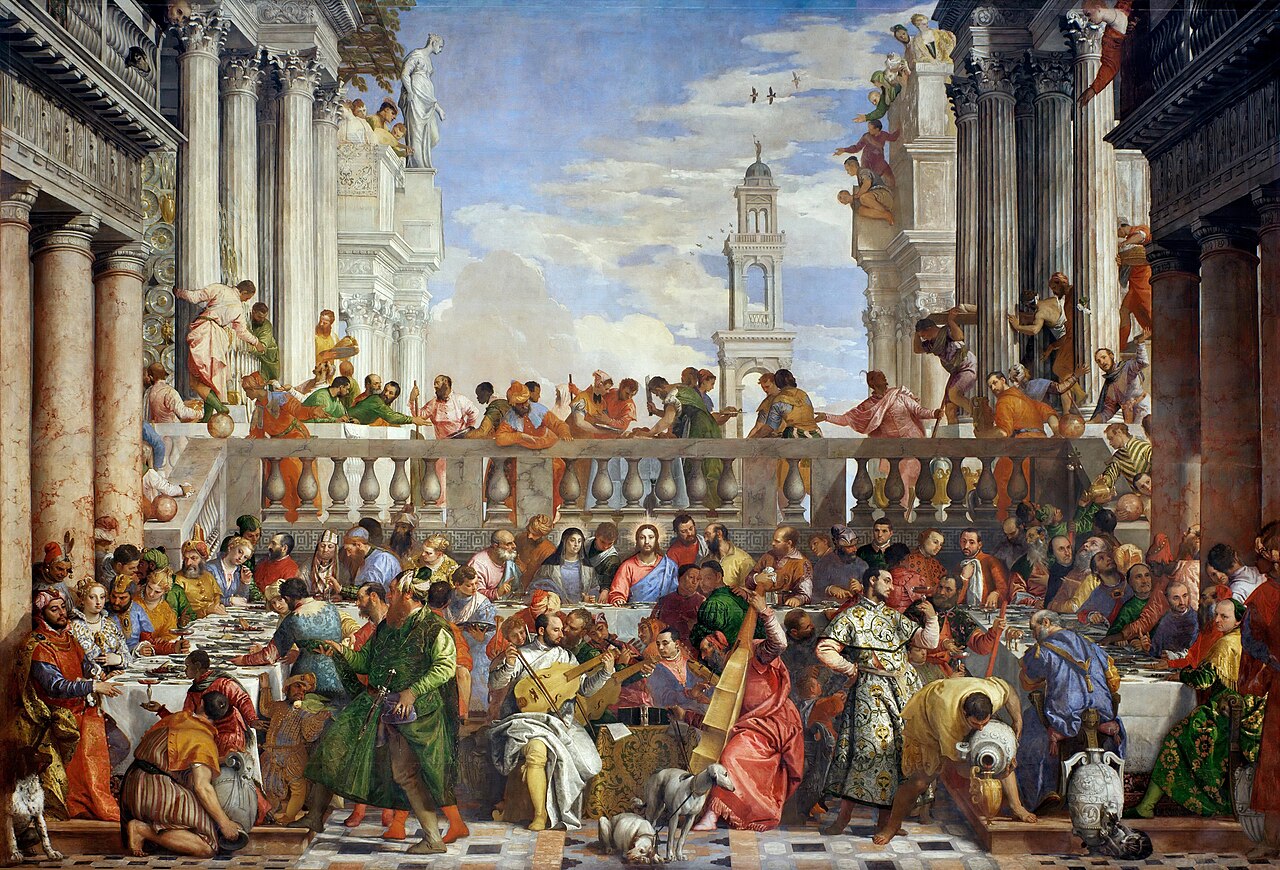 The Wedding Feast at Cana Nozze di Cana 1562-1563 by Paolo VeroneseThe account of the wedding at Cana, as recorded in the Gospel of John, offers a captivating narrative rich with symbolism and spiritual significance. Set in the picturesque town of Cana in Galilee, this story unfolds as a testament to Jesus' compassion, power, and the abundance of divine grace. Let's explore the profound layers of this transformative event.
The Wedding Feast at Cana Nozze di Cana 1562-1563 by Paolo VeroneseThe account of the wedding at Cana, as recorded in the Gospel of John, offers a captivating narrative rich with symbolism and spiritual significance. Set in the picturesque town of Cana in Galilee, this story unfolds as a testament to Jesus' compassion, power, and the abundance of divine grace. Let's explore the profound layers of this transformative event.
The scene opens on the third day of a wedding celebration, a joyous occasion marked by feasting and fellowship. Jesus, accompanied by his disciples, graces the festivities with his presence, underscoring the sanctity of marriage and the importance of communal celebration.
However, the joyous atmosphere is soon clouded by a pressing concern – the wine supply has run short. In a moment of maternal concern, Mary, the mother of Jesus, approaches her son with a simple yet poignant observation: "They have no wine." Her words carry a deeper significance, signaling a recognition of Jesus' divine capacity to address human need and transform the ordinary into the extraordinary.
Jesus' initial response appears enigmatic, as he cryptically remarks, "Woman, how does your concern affect me? My hour has not yet come." This seemingly curt exchange between mother and son unveils a deeper truth – that Jesus' ministry is governed by divine timing and purpose, and that the unfolding of miracles is intricately woven into the divine plan.
Read more: Introduction to 10 Miracles of Jesus - 1. The Wedding at Cana
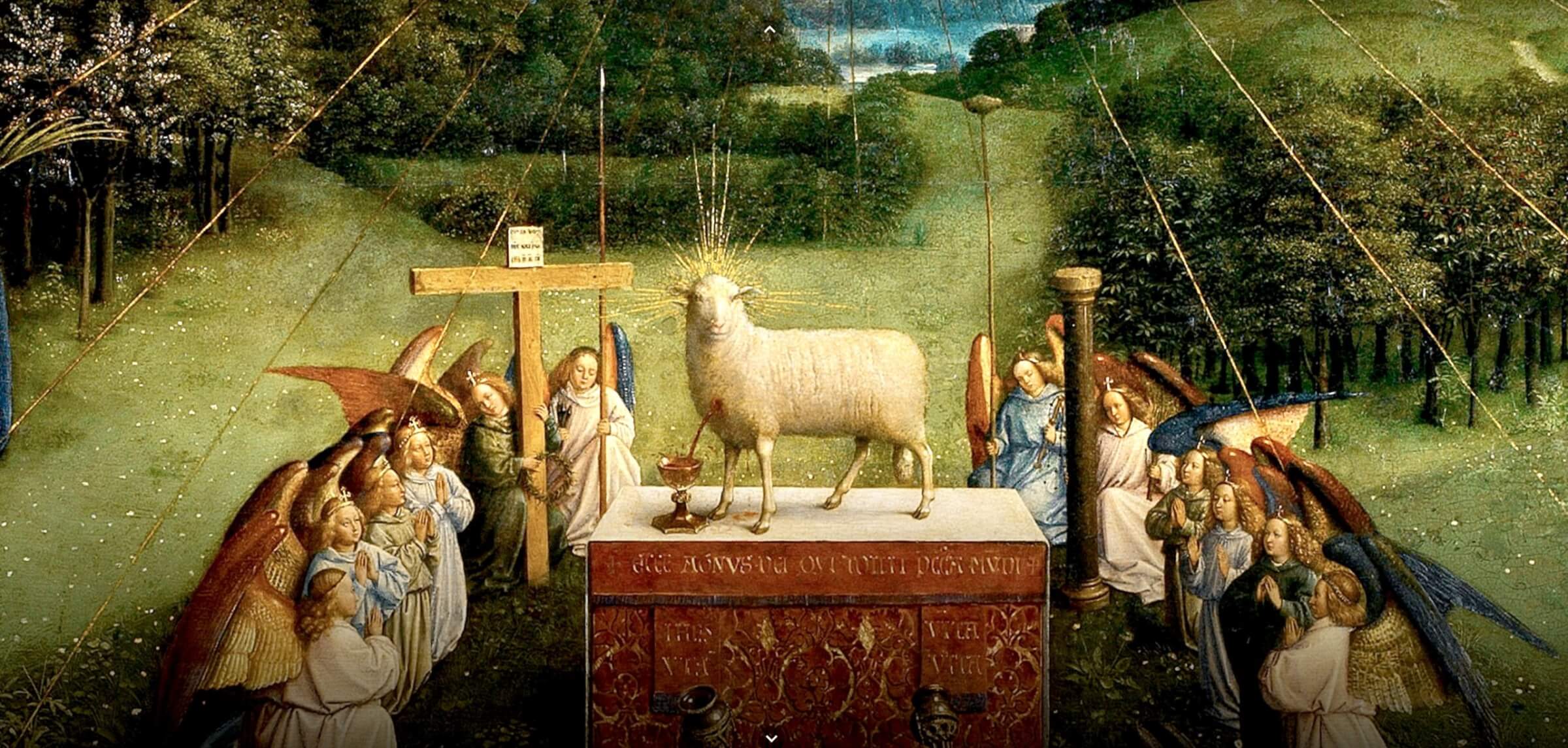 Van Eyck "The Lamb of God" Ghent Alterpiece - Painted in 1432
Van Eyck "The Lamb of God" Ghent Alterpiece - Painted in 1432
In the rich tapestry of Christian theology, few metaphors are as poignant and powerful as that of Jesus being referred to as "the Lamb." Found predominantly in the New Testament of the Bible, this imagery evokes deep theological significance, encapsulating the essence of Christ's sacrificial mission and the redemption he offers to humanity.
John 1:29: The Proclamation of John the Baptist
The Gospel of John opens with a striking declaration by John the Baptist upon seeing Jesus: "Behold, the Lamb of God, who takes away the sin of the world!" (John 1:29). In these words, John the Baptist not only acknowledges Jesus' divine identity but also foretells his sacrificial role in redeeming humanity from sin. By likening Jesus to a lamb, John draws upon the imagery of sacrificial offerings in Jewish tradition, symbolizing Jesus' ultimate sacrifice for the salvation of all.
Revelation: The Lamb Standing as if Slain
The book of Revelation provides vivid imagery of Jesus as the Lamb in various passages. In Revelation 5:6-14, a Lamb standing as if it had been slain is depicted at the center of heavenly worship, receiving adoration and praise from celestial beings. This imagery emphasizes Jesus' sacrificial death and victorious resurrection, underscoring his role as the focal point of divine worship and the source of redemption for humanity.